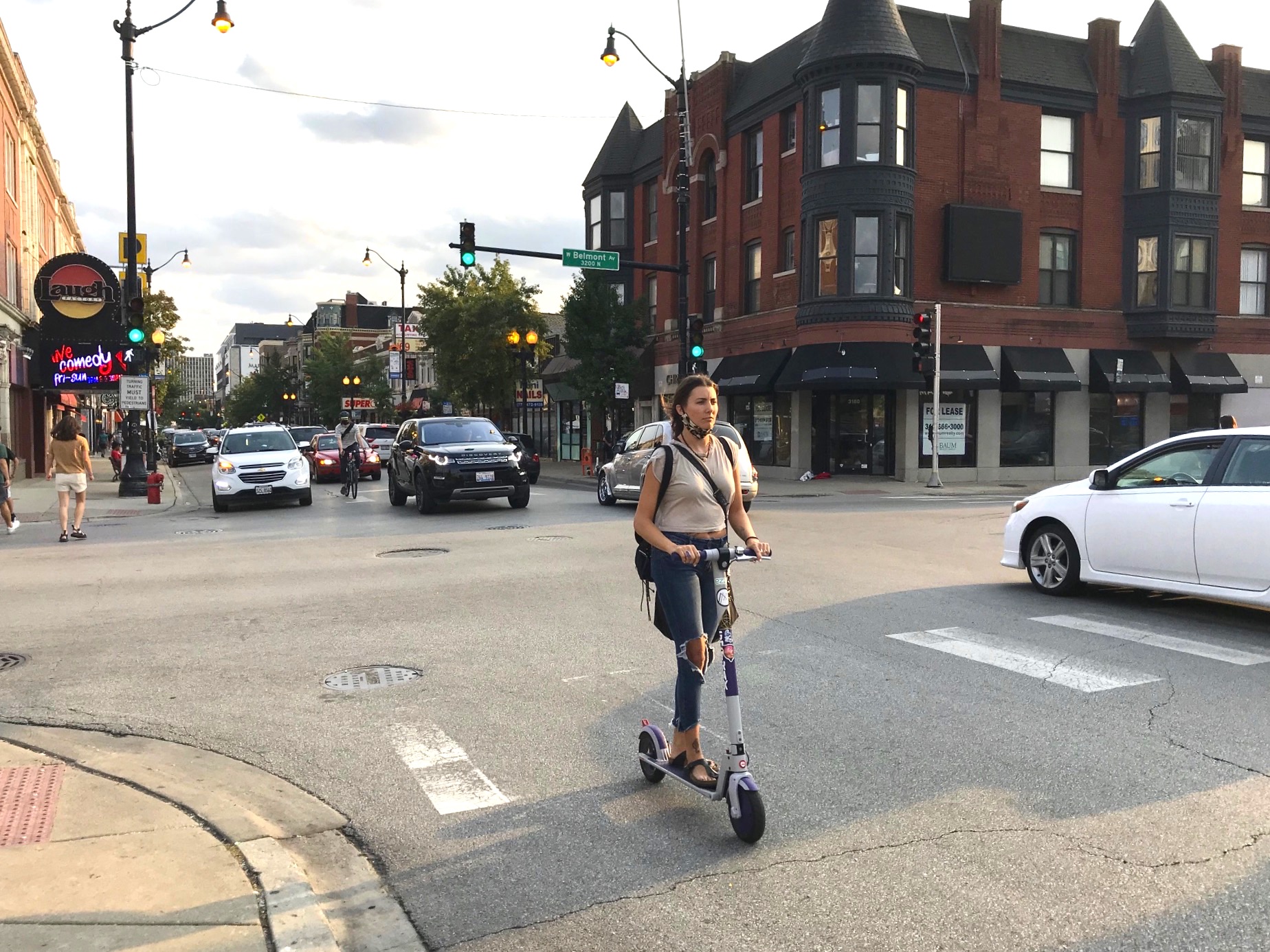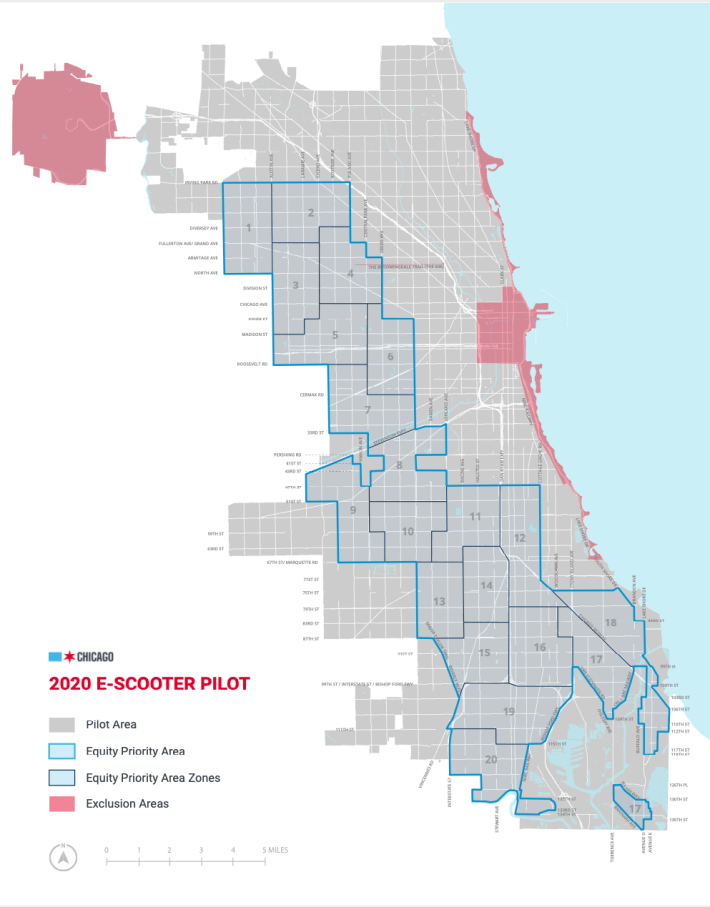City data indicates “Lock-to” rule is reducing e-scooter sidewalk blockage
6:27 PM CDT on September 16, 2020

Broadway in Lakeview appears to have lots of scooter traffic. Photo: John Greenfield
Earlier this month I noted that, thanks to the "lock-to" requirement for this year's dockless electric scooter pilot, which mandates that the devices must have in a built-in cable for securing them to bike racks or poles, "scooter-blocked sidewalks and trashed e-gadgets have pretty much gone the way of the dinosaur in Chicago." Data on the first month of the test released by the city of Chicago today backs up that observation.
The numbers, released by the Chicago Department of Transportation and Department of Business Affairs and Consumer Protection show that while more than 230,400 trips were taken in the first month of the test, over a service area that covers almost all of the city, complaints to 3-1-1 are down 60 percent compared to the 2019 pilot. 0.64 complaints per-day per-1,000 devices have been logged this year compared to 1.57 complaints per-day per-1,000 devices in the 2019 pilot. A total of 106 scooter-related reports have been filed through 311 through the first month of the 2020 pilot.
On the other hand, ridership per scooter is down this year. There were only 218,000 trips in the first month last year's pilot, but that test only included 2,500 vehicles, over a much smaller West Side coverage area. In contrast this year the three vendors, Bird, Lime, and Spin, can each deploy 3,333 of the gadgets anywhere in Chicago but downtown and the lakefront. There have been an average of 1.42 trips per day per device this year, compared to 4.76 trips per day per device in the first month of the 2019 pilot.
Average trip length in the first month of the 2020 pilot has been 1.87 miles, which is 34 percent longer than the average trip during the first month of last year's pilot. That may indicate that more people have been using the devices for commuting this year, rather than quick curiosity-motivated joy rides.
There's also some good news from an equity standpoint: Daily deployment to the South and West Side Priority Areas, which typically have less transit service than the North Side, is near the 50 percent goal. The priority areas cover 43 percent of the total pilot area. Through the first month, a daily average of 49.9 percent of the devices have been deployed to the Priority Area, only slightly below the goal and much better than the first month of the 2019 pilot in which only 28 percent of scooters were deployed in Priority Areas. Meanwhile, 26.8 percent of all trips occurred in the Priority Area in the first month of this year's pilot. Vendors have also been required to develop additional education and outreach to residents in the Priority Area.

“While initial demand is lower than last year’s pilot, we are encouraged by both the data and anecdotal reports from residents, advocates, and city staff that indicate the lock-to cable requirement has significantly reduced the number of instances of devices blocking sidewalks,” said CDOT commissioner Gia Biagi in a statement. “But we are still getting too many reports of people improperly and unsafely riding scooters on sidewalks. We are working with the three scooter companies to provide additional education to riders about the importance of safe riding practices.”
“We are encouraged by the results of the first month but continue to work to hold the companies accountable to our strict terms and requirements,” said BACP commissioner Rosa Escareño in a statement. “This pilot was designed thoughtfully and carefully to test this new mobility option, and we will continue this pilot proactively and diligently.”
The city says CDOT and BACP are closely monitoring the data gathered from the four-month pilot and testing devices to ensure compliance with the city’s rules. BACP recently completed the first enforcement mission of the pilot, testing scooters from all three companies to verify compliance with the pilot terms. As a result of the enforcement missions, BACP issued a total of 14 Notices to Correct across the three companies. These notices serve as formal warnings, mandating that companies get their acts together in order to avoid further enforcement and fines. The Notices to Correct were as follows:
Bird:
- Failed to rebalance designated share of scooters in each of the 20 Priority Sub-Areas
- Failed to launch the required number of scooters for the program and for each vendor
- Failed to relocate scooter parked outside of pilot area within two hours of notification
- Failed to have an operational warning bell on one or more of the inspected scooters
- Failed to provide information on scooter in braille and raised lettering
- Failed to display an app-based quiz that includes safety questions
Lime:
- Failed to rebalance designated share of scooters in each of the 20 Priority Sub-Areas
- Failed to launch the required number of scooters for the program and for each vendor
- Failed to correct scooter parked improperly within two hours of being reported
- Failed to have an operational warning bell on one or more of the inspected scooters
- Failed to have a clear opt-in policy for sharing data with third parties
- Failed to display an app-based quiz that includes safety questions
Spin:
- Failed to correct scooter parked improperly within two hours of being reported
- Failed to have a clear opt-in policy for sharing data with third parties
Biagi added that the city will begin requiring each vendor to place an educational hang-tag on each scooter for the remainder of the pilot reinforcing the need to lock the scooter to end a trip and reminding riders to not ride on sidewalks. She also said that the city has been working with the companies to adjust how they deploy scooters to mare sure that they do not take up all of the available space at bike racks, a pet peeve of local cyclists.
Starting before the launch of the pilot, the city has also been doing outreach to elected officials, chambers, neighborhood groups and residents about the process to request more bike parking at: bikeparking.chicagocompletestreets.org.
In addition to editing Streetsblog Chicago, John writes about transportation and other topics for additional local publications. A Chicagoan since 1989, he enjoys exploring the city on foot, bike, bus, and 'L' train.
Read More:
Stay in touch
Sign up for our free newsletter
More from Streetsblog Chicago
Johnson appoints one West Side pastor to CTA board, then nominates another West Side pastor for RTA board
Supporters argue that, despite his lack of transit expertise, Ira Acree’s social justice experience and political connections could be an asset for the RTA board.
Today’s Headlines for Thursday, April 26
The de-facto ban on riverwalk biking is back. What should we do about it?
In the short term, new signage is needed to designate legal areas for cycling on the path. In the long term CDOT should build the proposed Wacker Drive protected bike lane.


